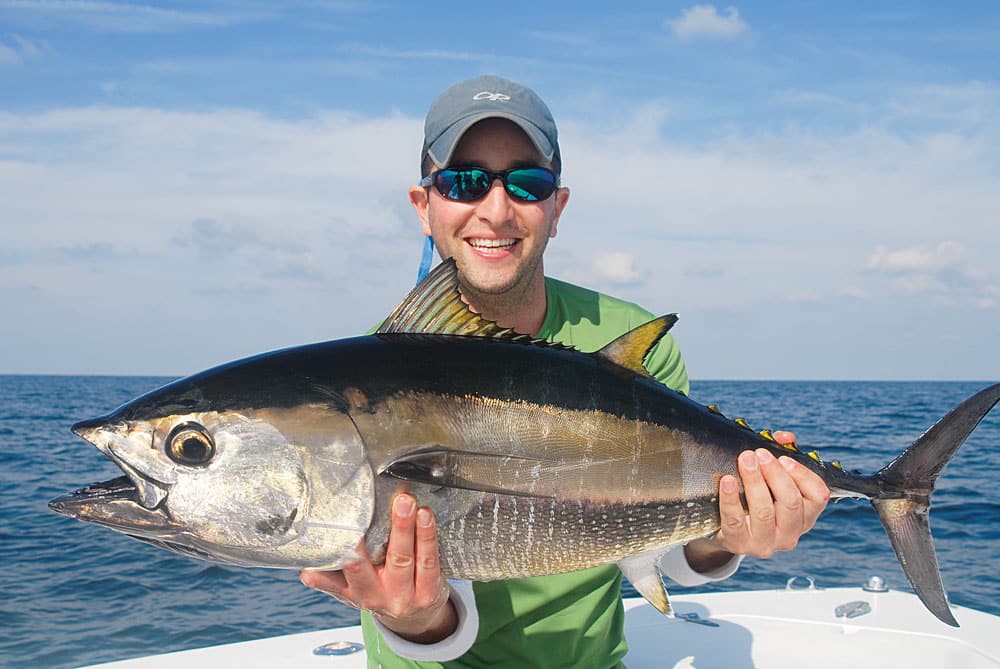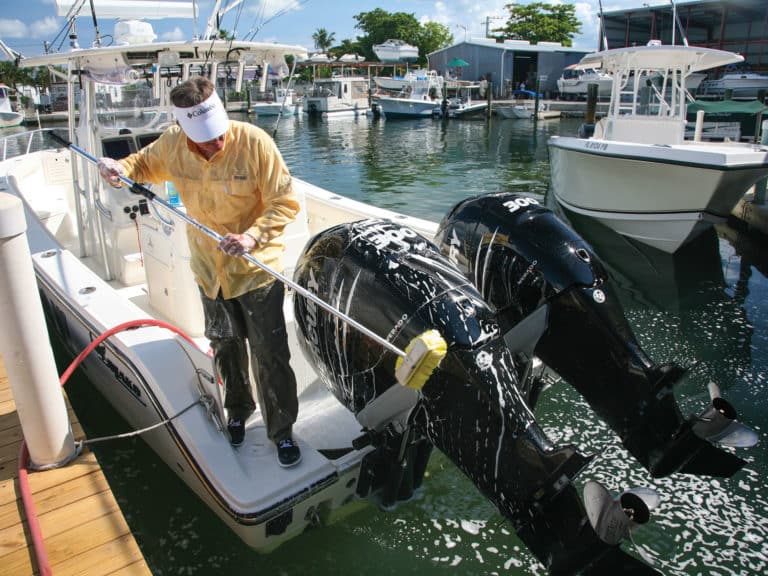
Report Your Bluefin Tuna
Bluefin tuna represent the new Mount Everest for fly-fishers. Considering the skill required to catch one, plus their size, speed, strength and endurance, they dwarf every other fish in the sea.
And there is nothing quite as intense as chasing pods of 100-plus-pound torpedoes as they slash through schools of halfbeaks or sand eels and often leap through the air to pounce on bait. If you manage to get one to eat a fly, brace yourself for a drawn-out battle that you likely won’t win.
More and more fly-anglers are getting a taste of this extraordinary fishery. That’s because there have been more and more bluefin around. Each year differs, but during the last six years, there have been more fish available to small-boat and center-console fishermen than in well over a decade. Plus they appear closer to shore, indicating a possible expansion of the stock. And not just in historically tuna-rich areas — this appears to be a coastwide phenomenon stretching from Maine to North Carolina and somewhat reminiscent of the good old days.
Still, according to National Oceanic and Atmospheric Administration reports, Western Atlantic bluefin (those fish that spawn in the Gulf of Mexico) are badly depleted, bouncing along at around 10 to 20 percent of where they were 30 years ago. The Eastern Atlantic stock (made up of those fish that spawn in the Mediterranean) is in no better shape.
**
Poster Children**
Bluefin are, in more ways than one, the poster children for poorly managed fisheries. Because of the high-priced sushi market, managers have consistently favored the short-term profits to be had from killing far more fish than scientists recommend over the long-term abundance of the species. As a result, the stock has suffered. Although there has been some recent tightening of restrictions, largely due to the threat of a trade ban, current rules are still generally recognized as half-measures.
Although some think that fishing for the Western Atlantic stock should have been shut down years ago, the fishery is actually managed very conservatively. Anglers can currently retain only one fish measuring 27 to 73 inches per vessel per day or per trip (note that this is not per person, but per boat). All boats are allowed one trophy fish over 73 inches per year.
The one-fish-per-boat recreational limit has discouraged a lot of anglers from making the trek out to the grounds and shut party boats almost completely out of the fishery. In my opinion, that’s a good thing, as recreational mortality likely would skyrocket if party boats were permitted to exploit the bluefin concentrations of late. Commercial fishermen cannot keep a fish under 73 inches, and the bag limit per boat is anywhere from three to five fish.
While such regulations have varied a bit from year to year, they’ve remained relatively tight. Over time, these, along with a few good bluefin spawning years, may have contributed to a slow recovery. Although the population likely is still a shadow of what it used to be and I would not advocate loosening the restrictions on the fishery, it’s pretty hard to deny that there are more fish around now than there have been in many years.
However, there hasn’t been any substantial uptick in estimates of catch or population abundance for Western Atlantic fish over the past six years. This is confounding given the exceptional bluefin fishery that’s literally sprung out of nowhere.
Why Can’t We See Proof?
It’s hard to say why this perceived abundance of bluefin isn’t showing up in NOAA Fisheries assessments. I tend to think it has at least something to do with anglers’ failure to comply with catch-reporting requirements. In some cases, that happens because the great majority of anglers just don’t know any better. In others, anglers or charter-boat captains knowingly refuse to participate. Neither reason is excusable.
By law, all recreationally caught bluefin tuna must be reported to the National Marine Fisheries Service within 24 hours of landing. This is easily done online at hmspermits.gov or by phone at 888-872-8862, yet very few people bother. Since Maryland and North Carolina have their own requirements, permit holders in those states declare their bluefin landings at designated state-operated reporting stations (for more info, call 410-213-1531 in Maryland or 800-338-7804 in North Carolina).
Of course, all anglers targeting bluefin must obtain an HMS (highly migratory species) permit every year. This is not just another $20 tax. NOAA Fisheries uses this list to gauge fishing effort. By calling permit holders, staff can estimate effort and vessel trips and then use dockside surveys (and reported harvest) to calculate catch-rate info. If contacted on the dock or by phone, recreational anglers must cooperate in the Large Pelagics Survey or Marine Recreational Information Program.
The NOAA estimates that compliance with recreational bluefin reporting requirements is a mere 20 percent. I’d suggest it’s even lower. As mentioned, a good part of that is ignorance. People simply don’t know that they are supposed to report these catches. And I fault NOAA Fisheries, as well as the fishing press, for not making the requirement better known. Yet there are a good number of bluefin anglers who simply ignore it. I regularly hear anglers and captains bragging about not participating in the phone or dockside surveys because they mistrust the NOAA and fear that if they report their catch, the fishery will be shut down. Others are just lazy. But their noncompliance hurts everyone.
**
Value Assessment**
The benefits of more accurate data should be self-explanatory. Better data would help ensure the long-term sustainability of the fishery. But accurate reporting would also fully demonstrate the recreational stake in the fishery. Simply put, if there’s no catch history, then for allocation purposes, there’s no catch. If recreational catch has been underreported, it will be underrepresented in the allocation. The bluefin tuna angling-category allocation of 19.7 percent is based on the historical recreational catch of 1983 through 1991. The allocation percentages have been modified slightly since they were first set in 1992 to reflect current effort and landings by fishing category (e.g., angling, longline, harpoon). Higher reported angling landings could lead to a bigger allocation for anglers in the future, but that won’t happen if a large majority of bluefin anglers don’t report their catch, which currently seems the case.
Compliance also would provide a more accurate calculation of the valueof recreational fishery. Several different groups, including the NMFS, American Sportfishing Association and U.S. Fish and Wildlife Service, undertake analyses of the value of recreational fishing in the United States. The number of trips and the species targeted are two important components of value calculations. Offshore fishing trips for bluefin are among the most expensive recreational outings available. If more trips are accounted for due to landings reports, the estimated value of recreational fishing increases. This figure is sometimes a key motivator for Congress and fishery managers to take actions that benefit anglers. As it stands now, the economic value of the commercial bluefin fishery simply dwarfs that of the recreational one.
Full reporting would also demonstrate a fuller utilization of the United States quota so the country does not lose share to other nations. I suspect a higher compliance rate would give an increased estimate of catch rates, which could show larger population sizes in assessments, which could lead to increased quotas. For example, in the case of bluefin tuna, the 2010 assessment of the Western Atlantic stock incorporated 12 time series (sequences of data points measured successively and spaced equally) of bluefin abundance. Two of the time series (fish ages 2 to 3, fish ages 4 to 5) were based entirely on annual catch by U.S. recreational fishermen since 1993. When higher catches are shown in these time series, the assessment reflects that as an uptick in the population size, even though in this case it was very small. A population assessed closer to or at sustainable levels would be able to withstand more fishing, meaning quotas could be increased.
The bottom line is this: Not reporting your bluefin catch as required by law is just stupid. Not participating in the phone or dockside surveys is equally brainless. It’s been well documented that the 2003/2004 year class was a good one. These fish, now in the 150-pound range, are finally beginning to show up in assessments, but it’s a very small uptick. The fact of the matter is that not only are we encountering these fish, but there appear to be fish from year classes both younger and older available. In other words, anglers are catching both larger and smaller fish, yet the numbers don’t reflect that. Given the 20 percent compliance estimate, I guess that’s not surprising.
I’m fine with the bluefin regulations, and frankly, I don’t think we need more than one fish per boat. But those who are complaining likely have no one to blame but themselves. Regardless, I’d like to see more accurate information on bluefin, as this will benefit the fish in the long run.









